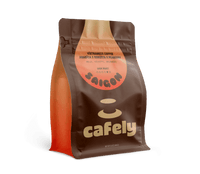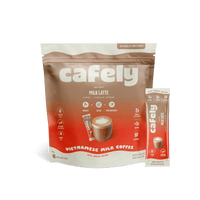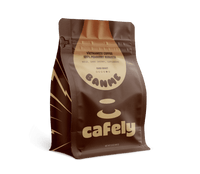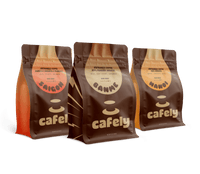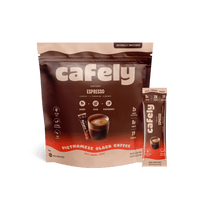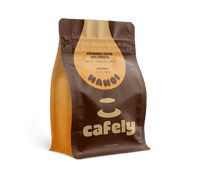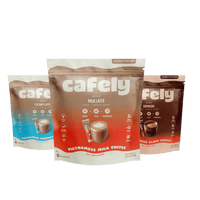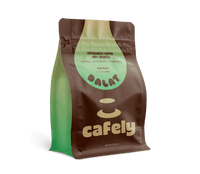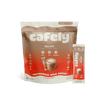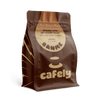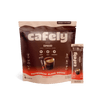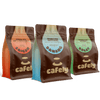You walk up to the counter, scan the coffee menu, and pause.
Flat white or cappuccino?
They both have espresso. They both use milk. But they taste nothing alike.
They may look similar at a glance, but the difference comes down to texture, flavor strength, and how each one feels when you drink it.
We’ll show you how a flat white stacks up against a cappuccino. You’ll learn how they’re built, how they taste, and which coffee gives you a stronger caffeine hit.
Quick Summary: Main Difference Between A Flat White & A Cappuccino
A flat white has less milk, no foam cap, and a stronger espresso flavor.
A cappuccino gives you equal parts milk and espresso, topped with thick, airy foam.
They both start with a delicious shot of espresso. But the texture and milk ratio change everything. The flat white feels silky and tight. The cappuccino feels light and airy. The experience in your mouth is totally different.
Same ingredients. Different technique. Totally different cup.
Flat White vs. Cappuccino: Taste & Texture
The taste is where the difference hits your tongue.
Flat White: Bold, Smooth, and Espresso-Forward
If you want a stronger coffee flavor without the bitterness, a flat white is your drink. You’ll taste the espresso first — not the milk. That’s because there’s less milk overall, and no thick foam to cut the flavor.
The milk in a flat white is steamed to microfoam. That means tiny bubbles you can barely see. It creates a silky, tight texture.
There’s no separation between milk and coffee; it feels unified, smooth, almost like a velvety shot of caffeine.
If you want coffee flavor to lead the show, the flat white keeps things bold but balanced.
Cappuccino: Light, Creamy, & Layered
The cappuccino is milder and creamier. That’s because the milk-to-espresso ratio is balanced. The thick foam layer on top adds softness and changes the way flavors land on your tongue.
You get three parts in every sip:
- A shot of espresso at the base.
- A layer of warm, steamed milk.
- A thick cap of foam — airy and soft.
This foam acts like a filter. It holds the heat longer and slows the coffee from hitting your tongue all at once. You get a lighter taste, a creamy texture, and a slightly sweet finish, especially if the barista dusts it with cocoa.
If you enjoy milkier coffees but don’t want to go full latte, the cappuccino gives you a sweet spot between foam and flavor.
Flat White vs. Cappuccino Texture: Silky vs. Frothy

This is where you’ll notice the biggest difference.
The flat white feels tight and velvety. There’s no thick foam. Just espresso blended with smooth milk. The microfoam blends into the drink without sitting on top.
The cappuccino feels light and airy. You get a thick cushion of froth with every sip. It’s soft, spoonable, and sits on top of the milk like a cloud.
So when you take a sip, the flat white pulls smoothly from start to finish. The cappuccino starts with foam, eases into milk, and ends in espresso.
Flat White vs. Cappuccino: Which Has More Caffeine?
A flat white typically contains two shots of espresso, delivering about 120 to 150 mg of caffeine, depending on the beans and extraction method. Because there’s less milk, the drink is more concentrated — meaning a stronger flavor and a bigger caffeine punch per sip.
A cappuccino, on the other hand, traditionally uses one shot of espresso, especially in Europe or smaller coffee shops. That equals around 60 to 75 mg of caffeine. In the U.S., many cafés use two shots in a standard 12-oz cup, which brings the caffeine content in line with a flat white.
While both drinks use espresso as the base, the volume and texture differ. A flat white is typically 5–6 oz with thinly steamed milk. A cappuccino runs 6–8 oz and includes a thick layer of foam. The extra size doesn’t mean more caffeine — just more air and froth.
Bottom line: If you want a bolder, more concentrated caffeine hit, go with the flat white. If you prefer a softer, more balanced drink with a lighter boost, a cappuccino's the better fit.
Flat White vs. Cappuccino: Milk Ratio & Foam Levels
Both drinks use steamed milk, but the texture, ratio, and structure are completely different.
Flat White: Microfoam Meets Bold Espresso
A flat white uses a smaller amount of milk, and that milk is steamed into microfoam, a silky, tight-textured foam with tiny bubbles.
There’s no thick froth layer sitting on top. Instead, the milk folds directly into the espresso, creating a smooth, velvety body that blends into the drink.
- Milk ratio: Roughly 1 part espresso to 2 parts milk
- Foam level: Thin layer of microfoam, barely more than steamed milk
- Texture: Compact, glossy, seamless
- Flavor: Espresso-forward, warm, and toasty
Because the foam stays minimal, the espresso flavor shines. If you enjoy the natural intensity of coffee but want a smoother edge, the flat white is built for you.
Cappuccino: Layered, Light, & Creamy
Cappuccinos are all about equal parts. That means the drink usually consists of 1 part espresso, 1 part steamed milk, and 1 part milk foam. The foam is intentionally thick and airy and light enough to sit on top, but dense enough to hold a dusting of cocoa or cinnamon if that’s your style.
- Milk ratio: Balanced between espresso, milk, and foam
- Foam level: Thick layer of froth
- Texture: Airy, fluffy, and distinctly layered
- Flavor: Milder, sweeter, more mellow
This extra foam lightens the overall feel of the drink. If you want a softer, creamier texture that leans more toward comfort than strength, cappuccino will hit the mark.
Flat White vs. Cappuccino: Side-by-Side Comparison
Here’s how the two drinks stack up, so you can picture the difference instantly:

Flat White vs. Cappuccino: Which One Should You Choose?
If you're standing at the counter trying to decide, here’s how to break it down.
Go for a flat white if:
You like a bold espresso flavor with a smooth, creamy texture, but without the foam overload. It’s also the better option if you want more caffeine in a smaller drink.
Choose a cappuccino if:
You’re into the ritual of milk foam, want a lighter mouthfeel, or just prefer something a bit mellower in taste. It’s comforting, airy, and less intense on the coffee side.\
How to Make a Flat White & Cappuccino at Home
You don’t need to visit a café every time you crave a flat white or cappuccino. With a few tools and a bit of practice, you can make both right in your kitchen.
Here’s exactly how to do it.
1. How to Make a Flat White at Home
If you want something strong, smooth, and silky, a flat white’s your best bet. It’s all about good espresso and perfectly textured milk.
What You’ll Need:
- Espresso machine, Moka pot, or Nespresso machine
- Milk (whole milk works best)
- Steam wand, milk frother, or French press
- Small ceramic cup or 5–6 oz glass
Here are easy steps to make a flat white at home:
Step 1: Brew a Double Shot of Espresso
Use 18 to 20 grams of finely ground coffee. Brew two shots of espresso (about 2 ounces total). If you’re using a pod machine or Moka pot, just make sure the result is strong and rich. You want a bold base.
Step 2: Steam the Milk to Make Microfoam
Pour about 4–5 oz of cold milk into your frothing pitcher. Use whole milk for best results; it stretches well and creates stable microfoam.
If you’re using a steam wand. Submerge the tip just below the surface. Keep the wand tilted and position the pitcher to spin the milk in a whirlpool. You’re aiming for tiny, uniform bubbles, not froth.
If you’re using a French press or frother. Heat your milk first (don’t boil). Froth using quick, steady plunges or circular motions until the texture turns glossy and smooth. Tap and swirl to remove large bubbles.
Step 3: Pour the Milk Slowly Over the Espresso
Hold your cup at a slight angle. Start pouring low and slow, aiming for the center of the espresso.
Once the cup is about halfway full, raise the pitcher slightly to allow the milk to flow beneath the crema. Finish with a slow, close pour for that velvety finish.
Your goal is a glossy surface with no thick foam layer. The milk should blend seamlessly into the coffee.
2. How to Make a Cappuccino at Home
If you’re in the mood for something airy, creamy, and balanced, cappuccino’s the way to go. The foam makes this drink stand out.
What You’ll Need:
- Espresso machine, Nespresso, or Moka pot
- Milk (whole milk preferred, but oat works too)
- Steam wand, milk frother, or French press
- 6 oz coffee cup
Here are easy steps to make a cappuccino at home:
Step 1: Brew One or Two Shots of Espresso
Traditional cappuccinos use one shot (about 1 oz), but if you want more strength, use two. Just make sure your cup can handle the total volume, including milk and foam, usually 6 oz max.
Step 2: Steam the Milk for Foam and Body
You’ll need about 4–5 oz of cold milk. You want to create both steamed milk and foam.
If you’re using a steam wand. Start with the wand near the surface to introduce air. You’ll hear a slight hissing sound. After a few seconds, lower the wand deeper to heat the milk. Spin the milk to keep it consistent.
If you’re using a milk frother or a French press. Heat the milk first. Froth until it expands in volume, forming light foam on top. Let it settle so you can separate the milk from the foam.
Step 3: Combine Steamed Milk and Foam Over Espresso
Pour your steamed milk over the espresso until your cup is about ⅔ full. Then, spoon thick foam on top until the cup is full. That thick top layer defines a proper cappuccino. It should be fluffy but not dry.
Sprinkle a bit of cocoa powder or cinnamon on top. Adds aroma and a nice finish.
Home Barista Tips
If you don’t have a steam wand, you may use a milk frother, hand whisk, or even a French press. Just heat your milk to around 150°F, froth until you reach your desired texture, then tap and swirl to smooth it out.
Milk choice matters.
- Whole milk gives the best foam and richest body.
- Oat milk froths well and brings a hint of sweetness.
- Almond milk can work, but may split unless steamed carefully.
Cup size makes a difference.
- Flat whites are best in a 5–6 oz cup, as it keeps the flavor strong.
- Cappuccinos need space for foam, so aim for a 6-oz cup.
Your day becomes better when you learn something new. Why not start with coffee?
FAQs: Flat White vs. Cappuccino
Here’s what you should know before you order or brew.
1. What Is the Strongest Coffee With Milk?
Flat white. It uses more espresso and less milk than a cappuccino.
2. Is a Flat White Stronger Than an Americano?

Yes, in flavor, but not always in caffeine. Americanos use more water, so they’re milder in taste, but may have higher total caffeine depending on size.
3. What Is a Cappuccino Without Foam Called?
That’s a latte. It’s made with espresso and steamed milk, but little to no foam.
4. What Is the Most Unhealthy Coffee?
Sugary blended drinks with syrups and whipped cream. Not flat whites or cappuccinos.
5. Which Coffee Has the Most Caffeine?
Drip coffee typically has the highest caffeine overall. But per ounce, espresso-based drinks like flat whites are stronger.
6. How Many Shots Are in a Cappuccino?
Usually one. Some cafés use two if you ask for a stronger version.
7. What Are the Benefits of Drinking a Flat White?
You get a bold coffee flavor with less milk. Great if you like strong, smooth espresso drinks without much foam.
8. How Many Shots in a Flat White?
Typically, two shots of espresso. That's standard in most cafés.
9. What Is the Best Coffee for Beginners?
Start with a cappuccino. It’s balanced, light, and has a creamy texture that’s easy to enjoy.
10. What Is the Difference Between Robusta and Arabica?
Arabica is smooth and mild. Robusta is stronger, more bitter, and has more caffeine. Explore more details on how arabica and robusta differ.
